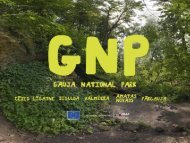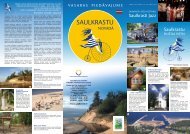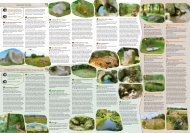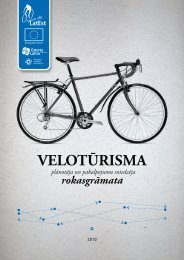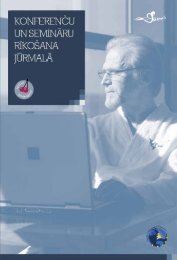City on the wave! - Latvian Tourism Development Agency
City on the wave! - Latvian Tourism Development Agency
City on the wave! - Latvian Tourism Development Agency
Create successful ePaper yourself
Turn your PDF publications into a flip-book with our unique Google optimized e-Paper software.
JŪRMALA<br />
ResoRt histoRy<br />
● During <strong>the</strong> 13th to 16th centuries most of <strong>the</strong><br />
current Jurmala city territory was included in<br />
former Liv<strong>on</strong>ian order state. Small fishermen<br />
villages started to emerge al<strong>on</strong>g seashore.<br />
● The oldest part of Jurmala is Sloka. Sloka <strong>on</strong><br />
<strong>the</strong> bank of river Lielupe flourished in <strong>the</strong> 17th<br />
century during governance of Duke Jacob. Kilns<br />
of copper, glass and lime, also mills started to<br />
operate here.<br />
● Kauguri: it is <strong>the</strong> part of Jurmala where most<br />
of Jurmala’s inhabitants live. The old name of<br />
fishermen village, Kaugern, first appeared in<br />
documents in <strong>the</strong> 16th century and suggests<br />
an idea that <strong>the</strong> first inhabitants here were<br />
Livs.<br />
● In its turn first summer residents in <strong>the</strong> end of<br />
<strong>the</strong> 18th century that lived in Kauguri village<br />
houses, mostly were Courland’s landlords.<br />
This fact allows coming to a c<strong>on</strong>clusi<strong>on</strong> that<br />
Jurmala is <strong>on</strong>e <strong>the</strong> oldest seaside resorts in<br />
Europe.<br />
● Up to 19th century fishery was <strong>the</strong> main<br />
branch of occupati<strong>on</strong> for <strong>the</strong> inhabitants of<br />
Jurmala. Fresh smoked fish was delivered to<br />
cottagers and was sent also to Riga.<br />
● Bathing places of Jurmala gained popularity in<br />
<strong>the</strong> 19th century.<br />
www.tourism.jurmala.lv<br />
● The beginning of <strong>the</strong> 19th century is <strong>the</strong><br />
dawn of Jurmala resort history. After <strong>the</strong><br />
war between Russia and France in 1812, <strong>the</strong><br />
wounded Russian army officers came to take<br />
rest at local fishermen houses.<br />
● The first ba<strong>the</strong>s’ establishment “Marienbad”<br />
in Dubulti was opened in 1870. Doctor Johan<br />
Christian Nordstrom started to use climate<br />
<strong>the</strong>rapy as a course of treatment; he indicated<br />
jogging al<strong>on</strong>g <strong>the</strong> beach, sea water treatments,<br />
as well as physical activities in fresh air.<br />
● The end of <strong>the</strong>19th century – beginning of<br />
<strong>the</strong> 20th century was <strong>the</strong> time when resort<br />
started flourishing; it was <strong>the</strong> time when most<br />
of health establishments, wooden architecture<br />
houses and resort infrastructure were built. In<br />
those days bathing houses with bathtubs of<br />
warmed sea water were built for <strong>the</strong> purpose<br />
of healing treatments and relaxati<strong>on</strong>.<br />
● In <strong>the</strong> beginning of <strong>the</strong> 19th century when<br />
no bathing suits were known, separate<br />
swimming hours for men and women were<br />
set. Since 1897 special hours for swimming<br />
in bathing suits were introduced – bathing<br />
suit c<strong>on</strong>sisted of trousers up to knee, and a<br />
sleeveless shirt with a belt. In 1914 swimming<br />
without bathing suits was banned.<br />
The united Jurmala city was established <strong>on</strong> <strong>the</strong> November 11, 1959<br />
merging 3 territories - Rigas Jurmala, Sloka and Ķemeri.<br />
● In 1844 <strong>the</strong> first steamboat in Jurmala started<br />
to operate and brought approximately 150<br />
passengers at a time. Later five steamboats<br />
were bringing people from Riga and Jelgava.<br />
The biggest steamboat “Undīne” started to<br />
run al<strong>on</strong>g <strong>the</strong> river in 1857, and was able to<br />
pick up approximately 500 pers<strong>on</strong>s. A street in<br />
Majori was named Undīnes in <strong>the</strong> h<strong>on</strong>our of<br />
<strong>the</strong> steamboat.<br />
● The opening of <strong>the</strong> railway line “Riga - Tukums”<br />
in 1877 was a notable event as it c<strong>on</strong>tributed<br />
to <strong>the</strong> development and growth of Ķemeri<br />
resort and Jurmala bathing places.<br />
● The first ir<strong>on</strong> bridge was built in 1876. During<br />
<strong>the</strong> World War I <strong>the</strong> bridge was det<strong>on</strong>ated<br />
when Russian army draw back. In 1922 a new<br />
railway bridge was opened, and again it was<br />
det<strong>on</strong>ated in <strong>the</strong> end of World War II, it was<br />
rebuilt in 1949.<br />
● “Jurmala’s gold” or famous strawberries<br />
came from Jurmala – <strong>the</strong> part of <strong>the</strong> city<br />
called Melluži. Fruitful strawberry gardens<br />
with high quality berries were located<br />
<strong>the</strong>re. Seeds of strawberries were brought<br />
from France, but ripe berries were<br />
delivered not <strong>on</strong>ly to Riga, but also to St.<br />
Petersburg.<br />
● Ķemeri regi<strong>on</strong> with its curative qualities<br />
of sulphur springs is well known since<br />
18th century. The first bathing house was<br />
built <strong>on</strong> state land in 1838. This land was<br />
allocated to <strong>the</strong> needs of sulphur springs<br />
vulnerary by <strong>the</strong> tsar Nikolay <strong>the</strong> 1st. This<br />
was <strong>the</strong> year of resort’s foundati<strong>on</strong>. Thus<br />
Ķemeri originally developed as a balneological<br />
resort, care of which was so<strong>on</strong> taken<br />
by <strong>the</strong> state.<br />
● Resort was wide known in <strong>the</strong> Russian<br />
Empire; in 1912 a direct railroad line Ķemeri –<br />
Moscow was opened. For a c<strong>on</strong>necti<strong>on</strong> with<br />
Jaunķemeri beach, an electric tram started to<br />
operate.<br />
● In 1920 city rights with <strong>the</strong> name of Rigas<br />
Jurmala were granted to <strong>the</strong> current territory of<br />
Jurmala from Priedaine to Kauguri.<br />
● In summer of 1950 as much as 29 sanatoriums<br />
and 36 rest houses were open in Jurmala.<br />
In its turn, in 1980-ies Jurmala according to<br />
<strong>the</strong> amount of organized guests, ranked 3rd<br />
after famous resorts - Sochi and Yalta. It was<br />
<strong>the</strong> time when in Jurmala 105 sanatoriums,<br />
guest houses, recreati<strong>on</strong> and creative activities’<br />
houses were open, and <strong>the</strong>y welcomed more<br />
than 300 000 pers<strong>on</strong>s a year.



